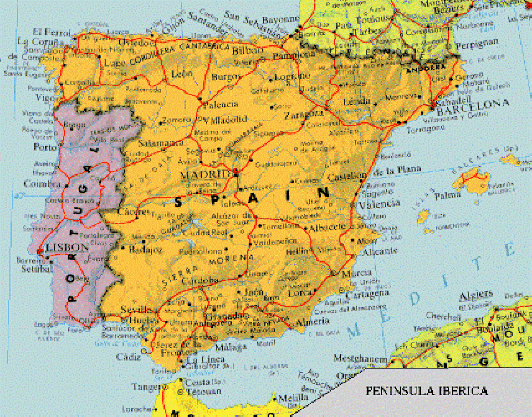
|
Geography Location: Southwestern Europe, bordering the North Atlantic Ocean and the Mediterranean Sea, between Portugal and France Area: Land boundaries: total 1,903.2 km, Andorra 65 km, France 623 km, Gibraltar 1.2 km, Portugal 1,214 km Coastline: 4,964 km Maritime claims: International disputes: Gibraltar question with UK; Spain controls five places of sovereignty (plazas de soberania) on and off the coast of Morocco – the coastal enclaves of Ceuta and Melilla, which Morocco contests, as well as the islands of Penon de Alhucemas, Penon de Velez de la Gomera, and Islas Chafarinas Climate: temperate; clear, hot summers in interior, more moderate and cloudy along coast; cloudy, cold winters in interior, partly cloudy and cool along coast Terrain: large, flat to dissected plateau surrounded by rugged hills; Pyrenees in north Natural resources: coal, lignite, iron ore, uranium, mercury, pyrites, fluorspar, gypsum, zinc, lead, tungsten, copper, kaolin, potash, hydropower Land use: Irrigated land: 33,600 sq km (1989 est.) Environment: Note: strategic location along approaches to Strait of Gibraltar PeoplePopulation: 39,302,665 (July 1994 est.) Population growth rate: 0.25% (1994 est.) Birth rate: 11.05 births/1,000 population (1994 est.) Death rate: 8.82 deaths/1,000 population (1994 est.) Net migration rate: 0.27 migrant(s)/1,000 population (1994 est.) Infant mortality rate: 6.9 deaths/1,000 live births (1994 est.) Life expectancy at birth: Total fertility rate: 1.4 children born/woman (1994 est.) Nationality: Ethnic divisions: composite of Mediterranean and Nordic types Religions: Roman Catholic 99%, other sects 1% Languages: Castilian Spanish, Catalan 17%, Galician 7%, Basque 2% Literacy: age 15 and over can read and write (1990 est.) Labor force: 14.621 million GovernmentNames: Digraph: SP Type: parliamentary monarchy Capital: Madrid Administrative divisions: 17 autonomous communities (comunidades autonomas, singular – comunidad autonoma); Andalucia, Aragon, Asturias, Canarias, Cantabria, Castilla-La Mancha, Castilla y Leon, Cataluna, Communidad Valencia, Extremadura, Galicia, Islas Baleares, La Rioja, Madrid, Murcia, Navarra, Pais Vasco Independence: 1492 (expulsion of the Moors and unification) National holiday: National Day, 12 October Constitution: 6 December 1978, effective 29 December 1978 Legal system: civil law system, with regional applications; does not accept compulsory ICJ jurisdiction Suffrage: 18 years of age; universal Executive branch: Legislative branch: bicameral The General Courts or National Assembly (Las Cortes Generales) Judicial branch: Supreme Court (Tribunal Supremo) Political parties and leaders: Other political or pressure groups: on the extreme left, the Basque Fatherland and Liberty (ETA) and the First of October Antifascist Resistance Group (GRAPO) use terrorism to oppose the government; free labor unions (authorized in April 1977) include the Communist-dominated Workers Commissions (CCOO); the Socialist General Union of Workers (UGT), and the smaller independent Workers Syndical Union (USO); business and landowning interests; the Catholic Church; Opus Dei; university students Member of: AG (observer), AsDB, Australian Group, BIS, CCC, CE, CERN, COCOM, CSCE, EBRD, AfDB, EC, ECE, ECLAC, EIB, ESA, FAO, G-8, GATT, IADB, IAEA, IBRD, ICAO, ICC, ICFTU, IDA, IEA, IFAD, IFC, ILO, IMF, IMO, INMARSAT, INTELSAT, INTERPOL, IOC, IOM (observer), ISO, ITU, LAIA (observer), LORCS, MTRC, NACC, NAM (guest), NATO, NEA, NSG, OAS (observer), OECD, ONUSAL, PCA, UN, UNAVEM II, UNCTAD, UNESCO, UNIDO, UNOMOZ, UNPROFOR, UPU, WCL, WEU, WHO, WIPO, WMO, WTO, ZC Diplomatic representation in US: US diplomatic representation: Flag: three horizontal bands of red (top), yellow (double width), and red with the national coat of arms on the hoist side of the yellow band; the coat of arms includes the royal seal framed by the Pillars of Hercules, which are the two promontories (Gibraltar and Ceuta) on either side of the eastern end of the Strait of Gibraltar EconomyOverview: After the economic boom of 1986-90, the Spanish economy fell into recession along with the economies of other EU member states. Real GDP barely grew in 1992 and declined by approximately 1% in 1993. Unemployment, now nearly one-fifth of the workforce, and the sharp downturn in business investment have contributed to sagging domestic demand. Devaluation of the peseta since September 1992 has made Spanish exports more competitive, but an export-led recovery in 1994 will depend largely on economic recovery in Spain’s major market – the other EU nations. A solid recovery will also require appropriate domestic policy actions, including controlling the budget deficit and wage increases, reforming labor market regulations, and possibly loosening monetary policy another notch. Foreign investors, principally from other EU countries, have invested over $60 billion in Spain since 1986. Despite the recession, inflation remained at about 5% in 1993. The main source of inflationary pressure is the fiscal deficit. National product: GDP – purchasing power equivalent – $498 billion (1993) National product real growth rate: -1% (1993) National product per capita: $12,700 (1993) Inflation rate (consumer prices): 4.5% (1993 est.) Unemployment rate: 22% (yearend 1993) Budget: |
